Questions and answers about the white-red-white flag
21 August 2020, 19:40 | Denis Martinovich, TUT.BY

One of the symbols of Belarus, the national white-red-white flag, is again at the center of public attention. Thousands of Belarusians are taking part in protests, but certain propagandists are still “allergic” to the flag. We explain in the simplest possible terms: when the flag appeared, why it has these particular colors, and how it began to be perceived as national rather than oppositional.
When did the white-red-white flag appear?
The modern white-red-white flag was created by the architect Klawdziy Duzh-Dushewski. During the 1917 February Revolution, Belarusian organizations from Petrograd asked him to create a flag for a Belarusian national movement. Duzh-Dushewski proposed several options, but the white-red-white flag was chosen. It is not known exactly when the sketch was made.
The first public “appearance” of the white-red-white flag took place in the spring of 1917 over the building housing the Belarusian Society for Aid to Victims of the War in St. Petersburg (Duzh-Dushewski worked for the society).

Source: Wikipedia
Sometimes, there are mentions of a legend in literature. There is a story of the battle of a prince, who removed a white bandage covered in blood and then led his troops to victory with this improvised flag. However, there is no such legend in Belarusian folklore. This story was born only in the 20th century. Stories claiming that our flag can be seen in paintings portraying events in the 16th or 17th centuries are also legends.
Why did the coat of arms appear earlier, and the national flag only much later?
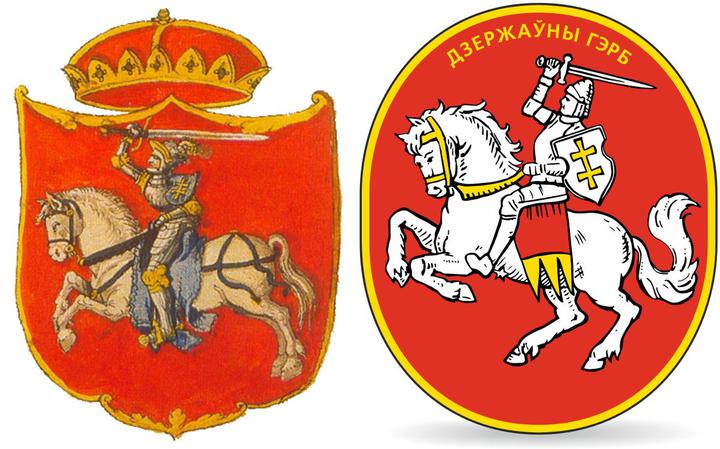
On the right — the coat of arms of the Belarusian People’s Republic.
Source: Wikipedia
The “Pahonia” coat of arms became the state symbol of the Grand Duchy of Lithuania in the second half of the 14th century, although its first version appeared even earlier. On the 1330 treaty between Polotsk and Riga, there was a seal of the Polotsk prince Narimantas which bore the image of a horseman, turned to the left, holding a sword.
A horseman with a sword against the background of a heraldic shield was also on the seals of Władysław II Jagiełło and Vytautas. Since then, the Pahonia was considered the official symbol of the Grand Duchy of Lithuania.
Why did the national flag appear after so many centuries?
“In ancient times, the primary symbol was the coat of arms; there were many different flags,” explained historian Sergey Yemelyanov. “Most often, the flags (standards) of monarchs were used as “state” symbols. Gradually, the tradition of using state flags appeared. In European countries, the use of flags (with some exceptions) emerged in the 19th and early 20th centuries.”
Where did the flag get its colors from?

As Sergey Yemelyanov explains, the colors of the flag did not appear at random. The white-red-white flag is associated with the Pahonia.
“The flag was derived from the coat of arms. To put it simply, it is the schematic representation of the colors in the Pahonia’s coat of arms (on a scarlet field, a silver horseman armed with a sword). It has two colors: scarlet (heraldic ‘red’) and silver (heraldic ‘white’). The scarlet color is an enamel while the silver is a metal (these are the groups of colors in heraldry). Enamels and metals must be alternated.
An enamel cannot be used with an enamel, nor can a metal be used with a metal. The creators of the flag of the Belarusian Soviet Socialist Republic (BSSR) did not know this, as red and green are both enamels.
In addition, white and red are both traditionally used in Belarusian folk culture. They are almost the genetic code of the nation. White and red were used in everyday life, in clothing. Red threads were woven in patterns on linens, a red belt was worn on a white shirt. The connection between these colors was inextricable and, in a certain sense, inevitable.”
How did the white-red-white flag become the national flag?
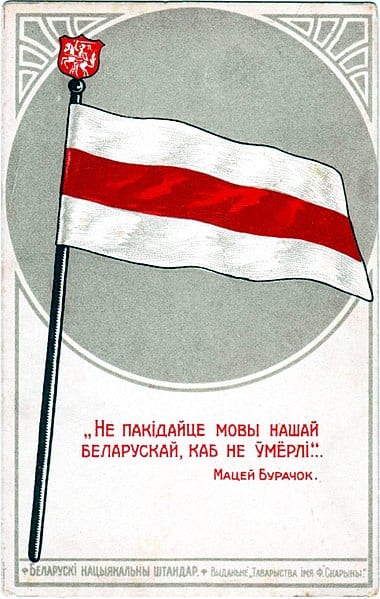
On 12 March 1917, white-red-white banners appeared in Minsk during the holiday celebrating the Belarusian badge. They were worn by soldiers on the front during World War I to identify themselves as Belarusians.
A white-red-white flag with the motto “For my native land, for a free Belarus” flew over the First All-Belarusian Congress which took place at the end of 1917.
As the historian Dorota Mikhalyuk wrote:
“… a Bolshevik commissar from Latvia insulted the Belarusian flag. He called it a ‘tricolour rag’ and demanded its removal. The reaction of those present was a testament to their strong emotional connection with white-red-white colors, which had been recognized as national symbols. Congress participants settled down only after General K. Alekeeuski, a delegate from the Belarusian army, stepped forward together with a sailor and a soldier, and then kissed the flag. Plishevich, a peasant from the Minsk province dressed in peasant garb, called upon the audience: ‘We must defend and respect the flag!’”
On 5 August 1918, the white-red-white flag became one of the state symbols of the Belarusian People’s Republic (BPR).
In the 1920s, the flag was used by participants in the Slutsk uprising, who fought against the Bolsheviks and sought to establish an independent Belarus.
The white-red-white flag was used in western Belarus by representatives of the Belarusian National Movement, who fought against Polish authorities for the country’s independence. The flag was also a symbol of Belarusian emigration.
Was the white-red-white flag used during the Nazi occupation?
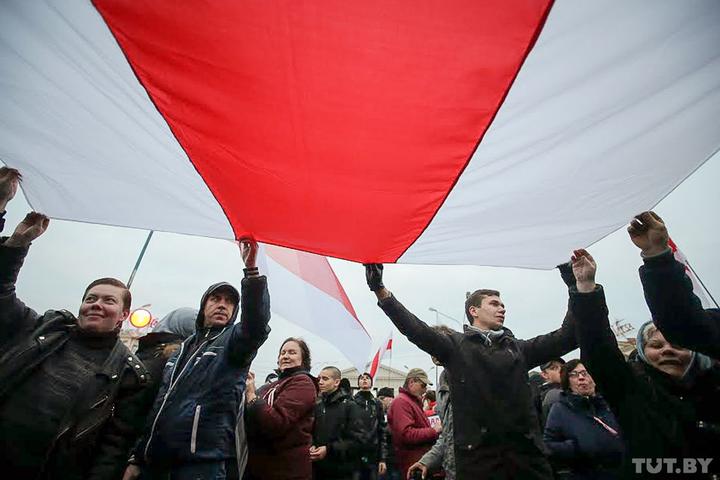
Yes, that is true. But before jumping to conclusions, read this section to the end.
Unfortunately, collaborators (people who knowingly, voluntarily or deliberately cooperated with the enemy against their own state) were, without exception, in all occupied countries in Europe. And they used their national symbols.
For example, the Vichy government used the national flag of France. The Russian Liberation Army under General Vlasov used the Andreevsky flag, and its separate formulations — the modern day Russian white-blue-red flag, etc. However, modern-day French, Russians and representatives of other nationalities do not abandon their own national symbols.
Why didn’t the Nazis use the red-green flag? It was only invented in 1951. Before that, the flag of the BSSR hardly differed from the flags of other Soviet republics. It was a red flag with a hammer and sickle and the inscription “БССР” (BSSR).
Let’s add one more argument. During the occupation, many churches were opened. It is clear that this was done for a propagandist effect. But believers are not required to become atheists without exception because of this fact.
Therefore, references to the time during the war are made not by historians, but rather by propagandists.
Why has the white-red-white flag long been affiliated with the opposition?
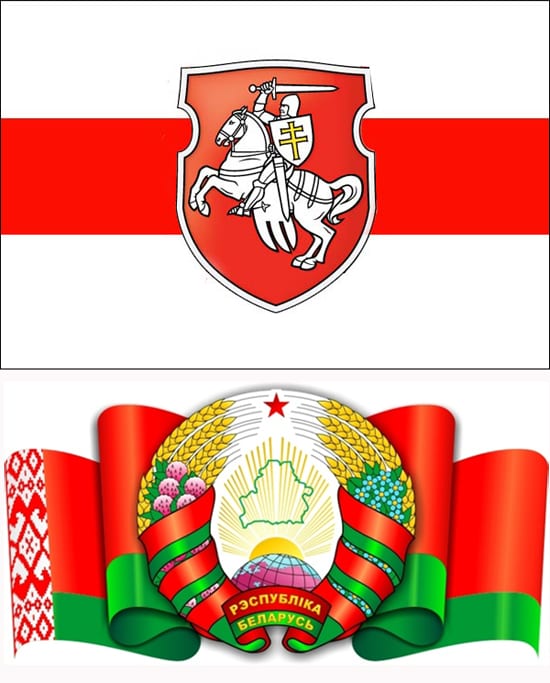
Source: Naviny.by
In 1991, the white-red-white flag became the state flag. But four years later, a referendum was held in the country, which resulted in the state flag becoming the symbol from Soviet times (albeit slightly changed) again.
The main opposition group at that time was the Belarusian Popular Front (BPF). According to Alexander Feduta, the author of the book “Lukashenko: A Political Biography”, it was the BPF that the government viewed as the main threat and wanted to do away with once and for all.
“This could be done only by cutting the weeds of trouble at the root, taking away from the enemy his most important conquests,” Feduta wrote.
If one sets aside the adoption of independence, then the main achievements of the BPF in society were the recognition of the Belarusian language as the state language and the adoption of Belarusian historic symbols (the white-red-white flag and the Pahonia coat of arms).
As a result, after the referendum, state-owned media began to associate the white-red-white flag exclusively with the opposition (in general) and with the BPF (in particular). This interpretation dominated for a long time and influenced the relationship between parts of society and the national symbols.
Why is the white-red-white flag again perceived by people as a national flag?
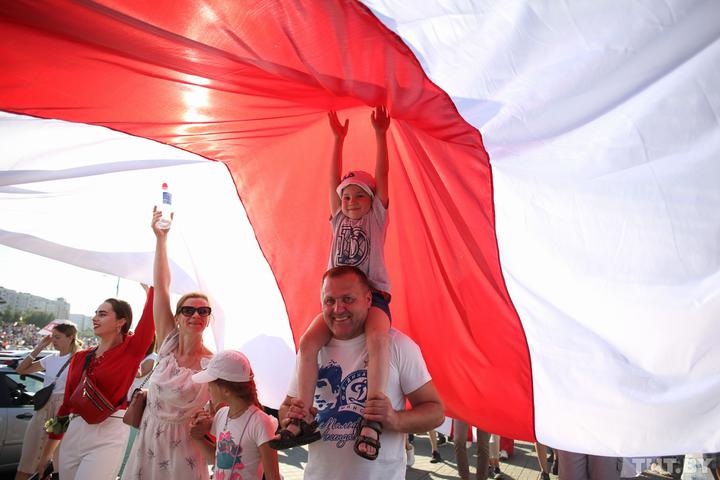
There are several reasons.
The opposition, in the old sense of that word, was almost entirely crushed. In the 2010s, parties (including the BPF) stopped setting the agenda. However, political activists in Belarus continued to participate in political events with the national symbols. As a result, the white-red-white flag stopped being interpreted exclusively as an opposition flag.
Mass protests also played a role.
“Now [the white-red-white flag] has been legitimized by the resistance to the violence which surrounded the first days of the protests. (…) The legend of the bandage covered in blood has reappeared in such an unusual way, through modern events,” explains analyst Sergey Chaliy. He believes that a reinterpretation of the white-red-white flag took place in the minds of the nation.
Finally, time has passed since the 1990s. A new generation has grown up, which studied in an already independent Belarus, learned about the country’s history and literature, and was able to draw its own conclusions.